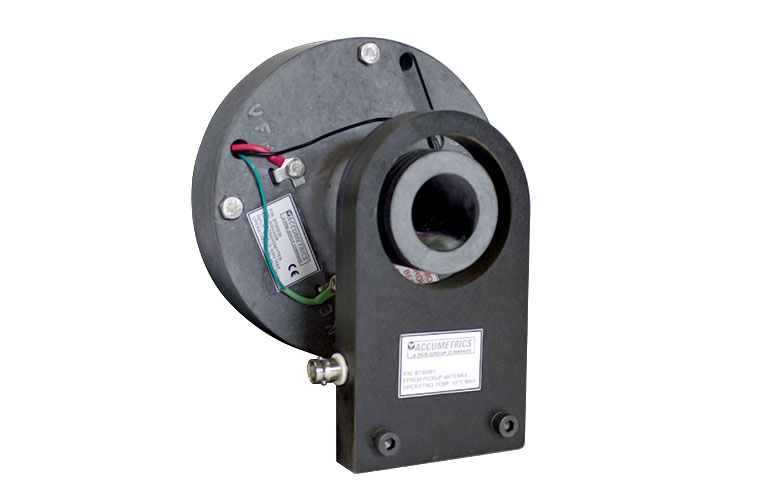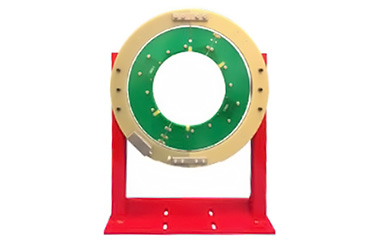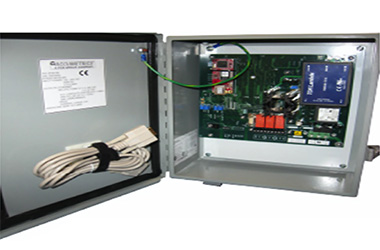Main Menu
The AT-8000 Earth Fault Resistance Monitor (EFREM) provides continuous wireless monitoring of insulation fault resistance and field voltage on brushless exciter generator/motor field windings, combining advanced ground fault measurement techniques with the latest innovations in digital telemetry. The system also provides users with condition monitoring data, allowing operators to monitor trends over time in order to make better informed operational and maintenance decisions.
Learn more about avoiding unnecessary downtime with
Accumetrics' EFREM.

Visualization of how the AT-8000 mid-shaft components are assembled.

Visualization of how the AT-8000 end of shaft components are assembled.
The detection of field ground faults on generators or synchronous motors with brushless exciters has always been difficult. Conventional field ground detectors may detect the occurrence of faults but provide no advance warning or indication of the fault’s severity. The severity at the detection threshold may vary by several orders of magnitude, depending on fault location.
By combining a new generation of 16-bit digital rotor telemetry technology for the measurement of generator ground faults, Accumetrics overcomes these limitations with EFREM. Measurement of actual resistance allows users to monitor trends over time and track the progression of ground faults from their onset. This provides an early warning of impending failure and allows for predictive maintenance of a machine. The severity of ground faults can be used in making operational and maintenance decisions.

End of Shaft EFREM

Mid-shaft EFREM

EFREM Receiver
| SPECIFICATIONS | |
|---|---|
| Field Voltage | |
| Measurement Range | 0 to 500 VDC (Contact factory for other ranges) |
| Measurement Transient without Damage | 1000 volts for 5 seconds |
| Resistance Measurement | |
| Measurement Range | 0 to 80 M ohms |
| Accuracy (readings through digital interface) | Sum of ±250 ohms and ±0.5% of reading over the range of 0 to 500k ohms (exclusive of the effects of AC content and noise from the excitation system) |
| Earth Fault Location Factor | |
| Range | 0 to 100% representing ratio of potential at fault to total field voltage (0 at negative terminal and 100% at positive terminal) |
| Accuracy (readings through digital interface) | ±1% for a 10k ohms fault. Computation of location factor of field voltage accuracy is specified for ≥25 V |
| Receiver | |
| Alarm Outputs | |
| Earth Fault | Two independent alarm resistance, user selectable via computer interface from 500 Ohms to 1M ohms |
| Malfunction | Active upon detection of a malfunction in Monitor operation or loss of receiver power |
| Alarm Interfaces | Form C relay; 6 A / 250 VAC |
| Analog Outputs | |
| Analog Outputs Option | Option: Dual analog outputs Field V and Log Resistance (4-20 mA) Note: this adds ±0.25% full-scale current loop inaccuracy |
| Digital Interface | |
| Computer Interfaces | RS232, Ethernet |
| Output Data | Earth Fault Resistance, Field Voltage, Location Factor when faults occur, Alarm and error conditions |
| User Settings | Alarm Resistance Thresholds, Dwell Times, Network Settings |
| Software | EFREM view data display and .CSV format PC data archiving |
| Power | 85 to 250 VAC 50 / 60 Hz, <20 W |
| Physical | |
| Transmitter Weight | 2.2 lb (1 kg) for shaft end mounting |
| Rotor Connections | Field Positive Terminal |
| Field Negative Terminal | |
| Rotor Earth/Ground | |
| Environment | |
| Ambient Temperature | 32−185 °F (0−85 °C) at Rotor Module 32−122 °F (0−50 °C) at Receiver Unit |
| Rotor Speed | 0 to 3600 RPM for center-line and mid-shaft mounting (≤16" Outer Diameter) Call factory for larger shaft diameters or specialized mounting |